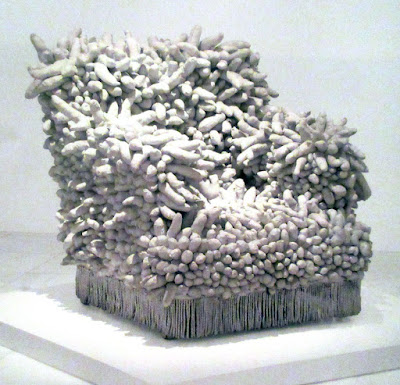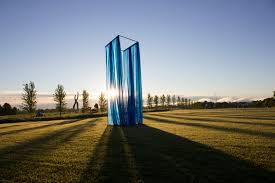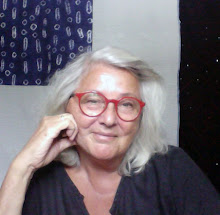 |
| self portrait 1950 oil on canvas 34 x 34 cm Yayoi Kusama |
 |
| Island No. 7 1953 watercolour and pastel on paper 30.5 x 26.5 cm Yayoi Kusama |
"I am pursuing art in order to correct the disability which began in my childhood." Y.K..
 |
| Dots on the Sun 1953 watercolour and pastel on paper 25 x 26 cm Yayoi Kusama |
She experimented early with materials and technique and set out to teach herself western style oil painting.
 |
| no. 8 H.A.P. 1956 oastel, gouache, acrylic on paper 58.4 x 45.7 cm Yayoi Kusama |
Her face, like Warhol's, is inseparable from her work.
 |
| No. White A.Z. 1958-59 (detail) oil on canvas 210 x 414 cm Yayoi Kusama |
 |
| No. B White 1959 detail oil on canvas 226 c 298 cm Yayoi Kusama |
 |
| Infinity Nets (white) 1959 detail oil on canvas 131 x 117.5 cm Yayoi Kusama |
 |
| No. T.W.3 1961 detail oil on canvas 174 x 125 cm Yayoi Kusama |
She did it herself.
She was an avid self-publicists. A writer of manifestos.
 |
| Accumulation No. 1 1962 sewn and stuffed fabric, paint, fringe on chair frame, 121 x 121 x 121 cm Yayoi Kusama |
This re-invention of her art, was unexpected and gained her publicity.
 |
| Accumulation 1963 sewn and stuffed fabric, wood chair frame, paint 90 x 97.8 x 88.9 cm Yayoi Kusama |
 |
| self obliteration no. 2 1967 watercolour, pen, pastel, photocollage on paper 40 x 50 cm Yayoi Kusama |
Yayoi Kusama continued to show new work alongside much younger artists in the biennial and triennial circuit international art scene. She lives in Tokyo today, and has a team of dedicated assistants. She continues to exhibit to even wider acclaim each year. Her new installations are based on the Infinity Mirrors that she began making in 1966.
Text in this post is derived from the introduction to the Tate Modern's catalogue for Kusama's 2012 exhibition written by Frances Morris. The images are also from that book.
August 2020 edit: David Zwirner represents Yayoi Kusama and this link to her work and life is most informative - Her manifestos, a survey of all her work, and much more are available here.
Above: Pumpkin 2015, Yayoi Kusama, stainless steel and red urethene paint 68 x 77 x 66 inches
Yayoi Kusama writes about Covid 19:
"Though it glistens just out of reach, I continue to pray for hope to shine through. Its glimmer lighting our way. This long awaited great cosmic glow.
Now that we find ourselves on the dark side of the world, the gods will be there to strengthen the hope we have spread throughout the universe. For those left behiind, each person's story and that of their loved ones, it is time to seek a hymn of love for our souls.
In thie midst of this historic menace, a brief burst of light points to the future. Let us joyfully sing this song of a splendid future. Let's go.
Embraced in deep love and the efforts of people all over the world, now is the time to overcome, to bring peace. We have gathered for love and I hope to fulfil that desire. The time has come to fight and overcome our unhappiness.
To Covid 19 that stands in our way, I say Disappear from this Earth. We shall fight. We shall fight this terrible monster. Now is the time for peope all over the world to stand up. My deep gratitude goes to all those who are already fighting." Yayoi Kusama April 2020






























